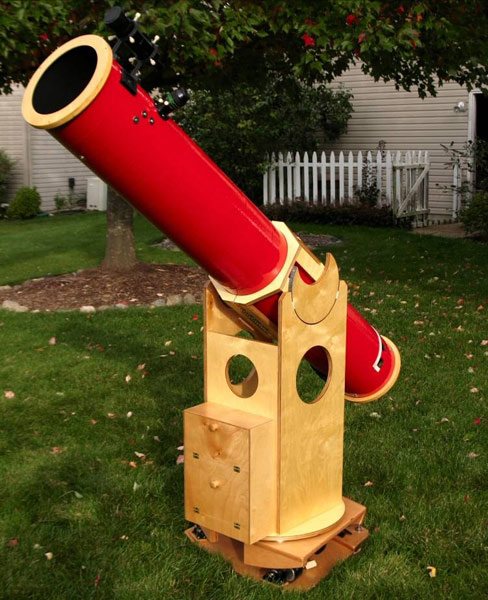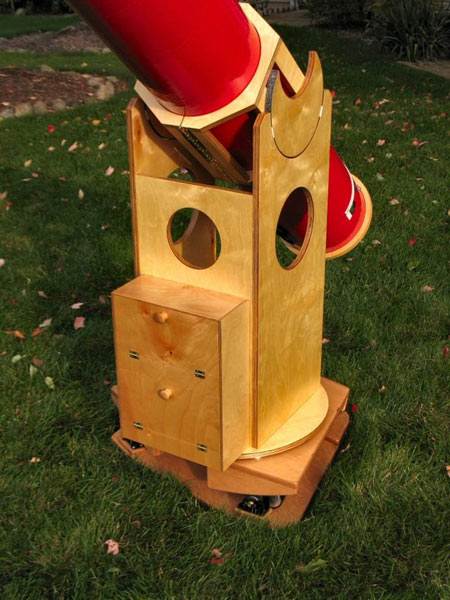

Most of you reading this are familiar with my 8-inch f/8 homemade Newtonian reflector I call “The Mars Scope”. I named it so because I made it specifically for the great Mars opposition of 2003. I used it a lot during that opposition, and made numerous observations and drawings of Mars late that summer. There were times when atmospheric seeing allowed me to push the scope to magnifications of 300 and sometimes even 400 diameters. The views were unforgettable.
Now you may also remember how I had that scope mounted—on an old, homemade (though not by me), equatorial pipe mount. That mount is solid, with very nicely machined bearings, and it steadily supports the weight and almost six-foot tube of the Mars Scope very well indeed.
But that mount has one serious drawback. Yes, it’s an equatorial, but it has no tracking capability. At 400 power, objects don’t stay in the field of view for very long. At that magnification it doesn’t even take half a minute for objects to sweep through the field. So when using the scope for its intended use, namely high-power lunar and planetary viewing, I spend almost as much time recentering the object in the eyepiece as I do actually observing. When trying to eek out as much detail from a high-power view as you can, having the target constantly moving is a distraction at best, and can make you miss detail at worst. The result is that after the 2003 Mars opposition, I’ve been using the scope less and less. For years I’ve tried to figure out how to add tracking to that old pipe mount, but never hit on a good way to do it. After all, I’m a woodworker, not a machinist!
All that is about to change. Last winter I had a “Eureka!” moment. Mark Deprest has for years used equatorial tracking platforms for his scopes, and he had purchased a nice, new platform from Equatorial Platforms for his newly acquired PK-457 (18-inch) Dob, which he later refurbished and renamed “Blondie”. I thought to myself, if I were to get one of those, I could put my 13-inch Dob “Papa Smurf” on it, and then build a Dob mount for the Mars Scope. I could add tracking to two scopes at once! Brilliant!
Because Equatorial Platforms’s platforms are made-to-order, based on your scope’s size and weight, I was a little concerned, wondering if one platform would work well with two different scopes. One is short, squat, and heavy, the other is relatively light and tall. Kind of a Mutt and Jeff situation. But after some email correspondence with Tom Osypowski, who runs Equatorial Platforms, my misgivings were relieved and I ordered a platform of my own.
The 13-inch, for which the platform is primarily designed, works splendidly on it. I simply push the scope around like I always have, but when I let go, the object in the eyepiece just sits there. Wow! How did I live without tracking on my scopes for all these years? It’s kind of like cruise control on your car. Once you have it, you wonder how you lived with-out it previously. Mark had always told me “Once you track, you never go back”. Now I know first hand what he means.
So now back to the purpose of this article, namely describing how I built the Dob mount for the Mars Scope. It’s pretty basic, but with a few little twists that I had to handle along the way. Tom Osy had told me that because the scope is tall, that I need to try to keep the center of gravity as low as possible. While the platform tracks, it can tip as far as seven and a half degrees each way as it runs through its fifteen degrees of travel. Keeping the CG low isn’t a problem for Papa Smurf, but it could be for the Mars Scope.

The length of the tube dictated that the rocker box had to be over 30 inches tall, so stiffness was of the utmost. Three-quarter inch Baltic Birch was the obvious choice. But Baltic Birch, which has all hardwood plies, is quite dense and heavy. So I had to build the upper portions as light as I could, without sacrificing stiffness. Still, it’s pretty basic Dobsonian construction. Basic box shape. Ebony Star Formica on Teflon bearings. But you won’t see any screw heads anywhere. I used biscuits and glue almost exclusively, except where screws can’t be seen from the outside. Because of all the dew to which I knew the scope would be exposed, I used Titebond III waterproof glue, stainless steel hardware, and Minwax “Helmsman” marine spar polyurethane on all exterior surfaces to make everything 100% dew-proof.
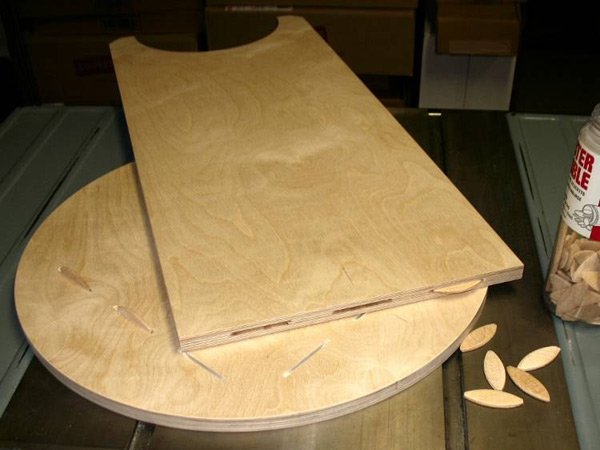
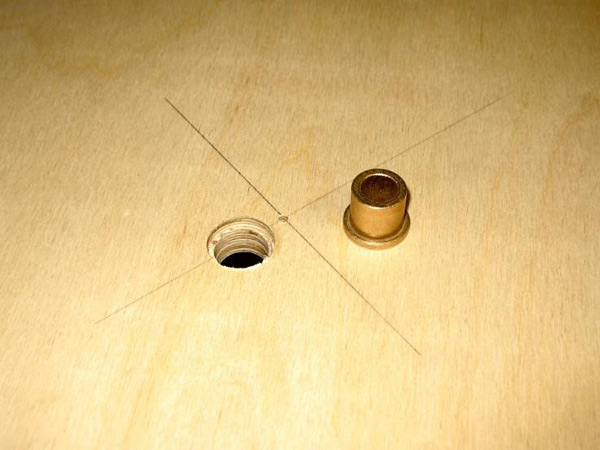
As you can see from the pictures, the clamshell-type cradle, which lets me easily reposition the tube for balance or eye-piece access, has a lot of open space. The cutouts in the upper end of the rocker box help keep things lighter up there also. Besides, I think the half-moon shaped altitude trunnions and the circular cutouts are kind of an artistic expression of the scope’s lunar and planetary purpose. Okay, maybe not.
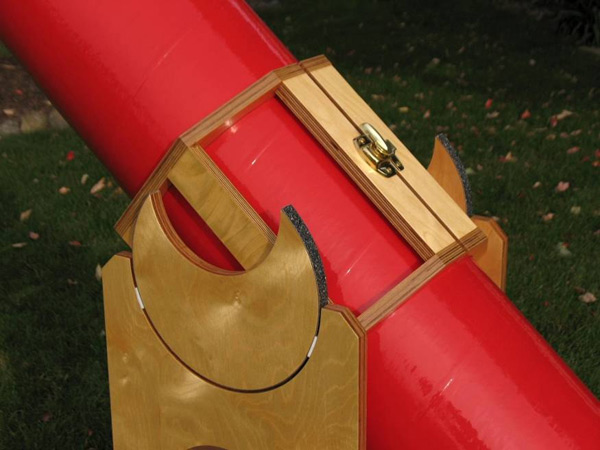
I really like keeping my eyepieces at hand at the scope, so I made up an eyepiece carrier that sits on the front of the rocker box, similar to the one I made for the 13-inch. Inside there’s enough room for six eyepieces, plus four filters. The hinged cover keeps everything dew free while not in use. The bottom compartment holds the battery for running the cooling fan, and the dew control that I intend to add to the scope. At five pounds, having the battery essentially at the bottom of the rocker box helps lower the center of gravity even more. Hanging the weight of the battery and eye-pieces on the front of the rocker box makes it a little front-heavy, so I offset the center pivot towards the front to compensate. It sounds a little anal, but with the tracking platform tipping one way and then the other, you really want things balanced as best as you can. A simple center of balance calculation after weighing everything told me how much of an offset I needed. I did the same thing with the altitude trunnions. They’re offset up in the cradle a little because the finder and eyepiece are usually going to be above the centerline of the tube. Add a camera and the amount of imbalance becomes potentially significant. Remember, good balance translates into good stability!
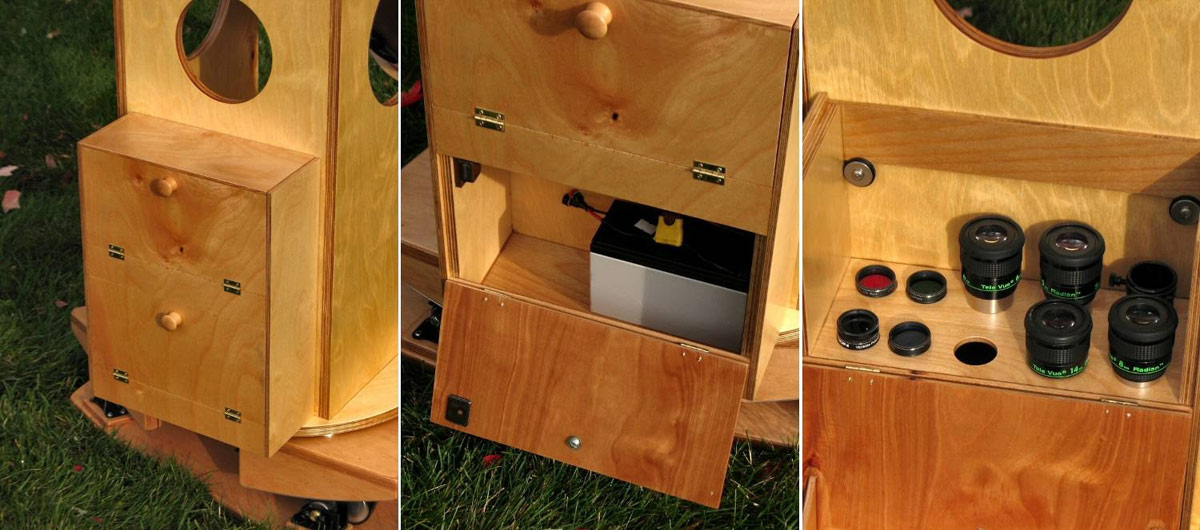
So how does it work? As it turns out, wonderfully. All my misgivings about the height making it unstable were unfounded. There’s no shakiness, no noticeable tendency to fall over. Just like with Papa Smurf, just point the scope and let go. It’s really that simple. It cost me maybe a hundred dollars or so (not counting the tracking platform), but being able to track at up to 400 power or higher is priceless. As Mark says, once you track, you never go back. Now you’ll be hearing me say that too. And you’ll be seeing the Mars Scope at open houses and observing events more often now too.
